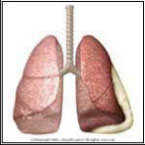Asphyxiation
Strangulation
In strangulation there is occlusion of the blood vessels in the neck secondary to external pressure.
3 types of strangulation:
Hanging
Ligature
Manual
Mechanism = Cerebral hypoxia secondary to obstruction of the vessels bringing oxygenated blood to the brain (carotid arteries)
Occlusion of airway usually does NOT occur, and is not the mechanism of death
Ocular petechiae is commonly seen in ligature and manual strangulations, but not with hangings
Introcular petechiae
Petechiae are believed to result from the rupture of venules and capillaries when the venous return from the head is obstructed, while the arterial blood flow to the head is maintained



Progressive Massive Fibrosis (PMF), is characterized by the development of large conglomerate masses of dense fibrosis (usually in the upper lung zones), and can complicate silicosis and coal worker's pneumoconiosis


Diffuse Alveolar Damage

Hyaline Membrane in DAD
Emypema
Empyema is a collection of pus in the pleural space



